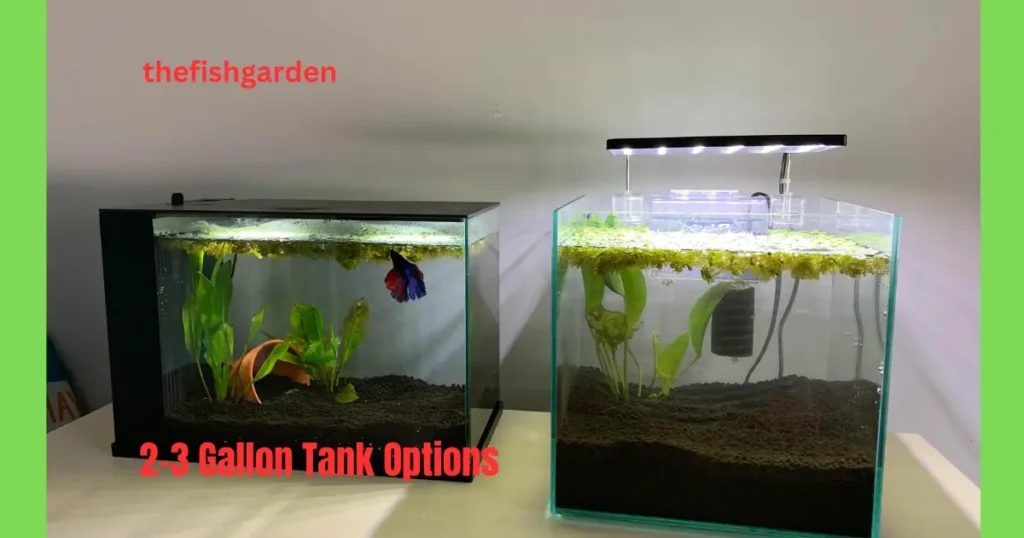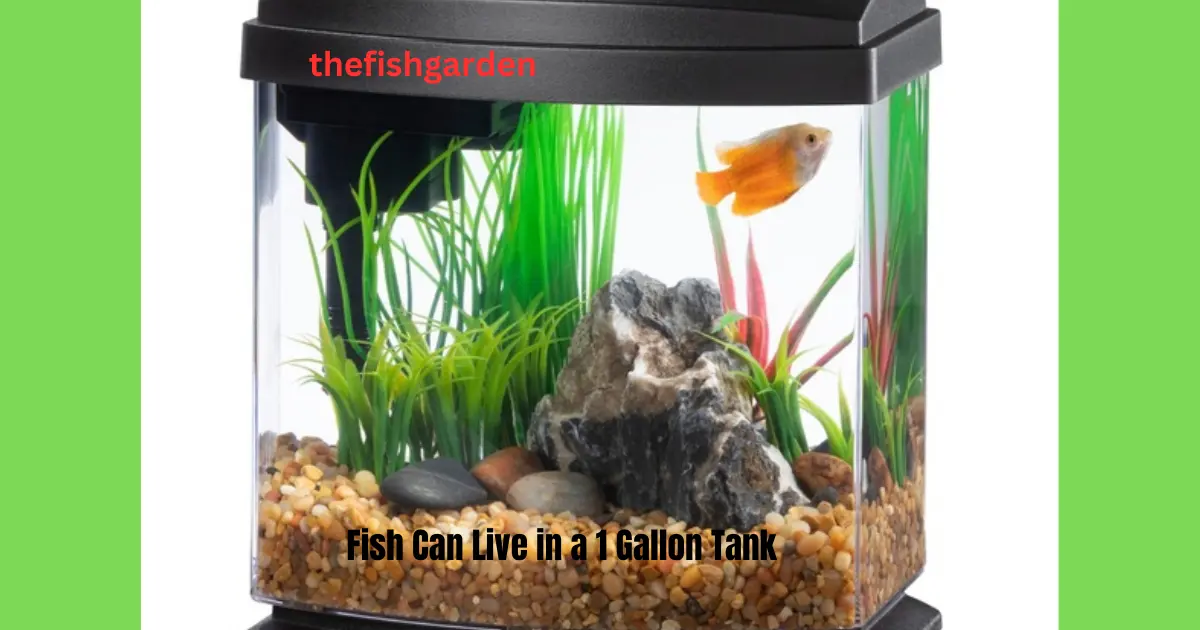A 1 gallon tank may seem very small, but it can actually house a few hardy fish species. With the right setup and care, a 1 gallon tank can be an appropriate home for certain small fish. Here is a comprehensive guide on what fish can live happily and healthily in a 1 gallon tank.
Key Considerations for a 1 Gallon Tank
Before choosing fish for a 1 gallon tank, there are some key factors to consider:
Space Limitations
- A 1 gallon tank has very limited space. Fish species need to stay small, under 2 inches maximum size.
- Avoid fish that are active swimmers requiring a lot of horizontal swimming space.
- Choose fish that stay mainly at the top or bottom of the tank.
Filtration Needs
- A small tank needs relatively heavy filtration to stay clean. Aim for a filter rated for at least double the tank size.
- Do frequent partial water changes, around 25% each week, to remove waste.
Heating
- Small tanks are prone to temperature fluctuations. A small submersible heater, around 25 watts, is recommended.
- Maintain a stable temperature between 72-82°F depending on the fish species.
Tank Setup
- Include lots of plants to help absorb fish waste. Java moss, java fern, anubias are low light options.
- Use a bare bottom or very fine gravel substrate for easier cleaning.
- Provide small hideaways and resting spots near the bottom.
Best Fish for a 1 Gallon Tank
Taking into account space limitations, filtration needs, and appropriate tank conditions, here are some of the best fish species that can live in a 1 gallon tank:
Guppies
<img src=”guppies.jpg” alt=”Guppies” width=”300″ height=”200″>
- Max size: 1.5 inches
- Care level: Beginner
- Conditions: 72-82°F, pH 7-8, soft to moderately hard water
- Notes: Best in pairs or trios, only males or females. Avoid keeping males and females or they will breed.
Endler’s Livebearer
<img src=”endlers.jpg” alt=”Endler’s Livebearer” width=”300″ height=”200″>
- Max size: 1.5 inches
- Care level: Beginner
- Conditions: 72-82°F, pH 7-8, soft to moderately hard water
- Notes: Peaceful nano fish. Males are colorful. Avoid keeping males and females or they will breed.
Betta Fish
<img src=”betta.jpg” alt=”Betta Fish” width=”300″ height=”200″>
- Max size: 2-3 inches
- Care level: Beginner
- Conditions: 75-80°F, pH 6-8, soft water
- Notes: Only one betta per tank. Prefer minimal water flow. Males are more colorful.
Shrimp
<img src=”shrimp.jpg” alt=”Shrimp” width=”300″ height=”200″>
- Species: Ghost, cherry, Amano shrimp
- Max size: 1-2 inches
- Care level: Beginner
- Conditions: 70-80°F, pH 7-8, soft to moderately hard water
- Notes: Peaceful and active. Need hiding spots and plants. Start with 5-10 shrimp.
Snails
<img src=”snail.jpg” alt=”Snail” width=”300″ height=”200″>
- Species: Nerite, mystery, ramshorn snails
- Max size: 1 inch shells
- Care level: Beginner
- Conditions: 70-80°F, pH 7-8, soft to hard water
- Notes: Help clean algae. Start with 1-3 snails. Some species breed readily.
2-3 Gallon Tank Options

While the above fish and inverts are suitable for 1 gallon tanks, the following options could work in upgraded 2-3 gallon tanks:
Tetras
<img src=”tetras.jpg” alt=”Tetras” width=”300″ height=”200″>
- Species: Ember tetra, neon tetra, glowlight tetra
- Max size: 1-1.5 inches
- Conditions: 72-82°F, pH 6-7, soft water
- Notes: Keep 6-8 tetras minimum. Peaceful schooling nano fish.
Rasboras
<img src=”rasboras.jpg” alt=”Rasboras” width=”300″ height=”200″>
- Species: Chili rasbora, mosquito rasbora
- Max size: 1-1.5 inches
- Conditions: 75-80°F, pH 6-7.5, soft water
- Notes: Keep 6-8 rasboras minimum. Peaceful schooling nano fish.
Pencilfish
<img src=”pencilfish.jpg” alt=”Pencilfish” width=”300″ height=”200″>
- Species: Dwarf pencilfish
- Max size: 1-2 inches
- Conditions: 73-82°F, pH <7.0, soft water with plants
- Notes: Shy, peaceful schooling fish. Keep 6 minimum.
Setup Guide for a 1 Gallon Planted Tank
A simple yet effective 1 gallon planted tank setup can provide a healthy home for the fish and inverts mentioned above. Here is a step-by-step guide:
Supplies Needed
- 1 gallon glass tank with lid
- Small internal power filter OR sponge filter
- Mini aquarium heater, 25 watt
- LED aquarium light OR desk lamp with CFL bulb
- Aquarium thermometer
- Live plants: java moss, java fern, anubias nana, marimo moss balls
- Gravel substrate or bare bottom
- Decorations – small hideouts, rocks, driftwood
Step 1: Wash the Tank
Thoroughly wash the new tank with water only – no soap. Rinse the gravel substrate if using.
Step 2: Install Filter and Heater
Set up the small filter or sponge filter. Position the mini heater horizontally along the bottom.
Step 3: Plant the Tank
For a 1 gallon planted tank, stick to low light plants like moss, ferns and anubias. Plant densely. Floating plants also work well.
Step 4: Add the Substrate and Decor
Add the gravel or leave the bottom bare. Arrange decorations and hiding spots appropriately.
Step 5: Fill the Tank and Dechlorinate
Fill the tank with dechlorinated water up to the filter’s water line. Turn on filter and heater.
Step 6: Cycle the Tank
Cycle the tank fishlessly for 4-6 weeks. Test ammonia and nitrites regularly and do partial water changes when levels rise.
Step 7: Test Water Parameters
After cycling finishes, test the water parameters. The tank is ready when ammonia and nitrites read 0 ppm, and nitrates read <20 ppm.
Step 8: Acclimate and Add Fish
With ideal water parameters, carefully acclimate and add the chosen fish or inverts. Start with a very low stocking level.
Step 9: Maintain the Tank
Going forward, test water weekly and do 25% partial water changes. Remove algae growth and dead plant matter promptly.
FAQ
Here are answers to some frequently asked questions about keeping fish in 1 gallon tanks:
What is the ideal water temperature range for a 1 gallon tank?
72-82°F is the ideal temperature range for most small tropical fish and inverts suitable for 1 gallon tanks. Use a mini aquarium heater to maintain a stable temperature.
How often should I change the water in a 1 gallon tank?
Aim for one 25% partial water change per week. Test the water 1-2 times per week and change water if ammonia or nitrites start to rise above 0 ppm.
Can I cycle a 1 gallon tank fishlessly?
Yes, absolutely. Fishless cycling with pure ammonia or fish food takes 4-6 weeks for a 1 gallon tank. Monitor parameters and do partial water changes when ammonia and nitrites spike.
What fish species should be avoided in 1 gallon tanks?
Avoid common fish like goldfish, danios, platies, and barbs that get too large and active for 1 gallon tanks. Also avoid aggressive species like dwarf cichlids.
Should I get a snail or shrimp for a 1 gallon tank?
Both shrimp and snails work well in 1 gallon planted tanks. Start with 1-3 shrimp or snails, and make sure to provide hiding spots and soft plant leaves for them to graze on. Popular options include cherry shrimp, ghost shrimp, Nerite snails, and mystery snails.
Can male and female livebearers be kept together in a 1 gallon tank?
It’s generally not recommended. The small space will likely result in breeding, leading to overcrowding issues. Keep male guppies, male endlers, or a single female livebearer instead. Introduce more hiding spots if keeping a female who may get harassed.
How often should I feed fish in a small 1 gallon tank?
Only feed very small pinches of food once or twice a day. One key is to feed only what the fish can quickly eat, as excess food fouls the water much faster in a small tank volume. Target feed shy bottom fish directly.
Why are frequent partial water changes important for a 1 gallon aquarium?
In such a small water volume, ammonia and nitrites can spike rapidly from fish waste and excess food. Frequent partial water changes of 25-30% weekly helps remove dissolved organic compounds and maintain safer water quality in between the small tank size.
Conclusion
While a 1 gallon tank is still limited compared to larger nano tank options, it can work well for select small fish, shrimp and snail species. Pay special attention to filtration, heating, tank cycling, and frequent water partial changes. Stock very lightly, provide ample plants and hides, and maintain stable water parameters. With some added effort, a 1 gallon planted aquarium can thrive.
Can I add a small algae eater to help clean a 1 gallon tank?
It’s generally not recommended, as most algae eaters get too large for a 1 gallon tank. Otocinclus catfish and dwarf suckermouth plecos may eat algae but need at least 5-10 gallons. Snails are a better option for algae control in a 1 gallon.
What kind of filtration is best for a 1 gallon aquarium?
Aim for a filter rated for at least 2-3X the tank size. A small internal power filter or air-driven sponge filter provides the best gentle water movement and filtration capacity needed. Avoid unstable undertank mini filters.
How many fish can I add to a 1 gallon tank?
Realistically, 1-3 very small fish is the limit, along with a couple shrimp or snails. Tiny species like a single betta, guppy trio, or 6 neon tetras can work with diligent care and maintenance. Always start with very low stocking.
Can I divide a 1 gallon tank into sections for multiple bettas?
No, dividing a 1 gallon tank cuts the already limited space too small for any fish. Bettas need a minimum of 2.5 gallons each preferably. Only keep one betta in a 1 gallon tank.
Do I need live plants in a 1 gallon aquarium?
Live plants are highly recommended. They absorb fish waste, provide oxygen, and create a more natural habitat. For a 1 gallon, aim for several easy low light plants like java fern, anubias, floating plants, and moss.
